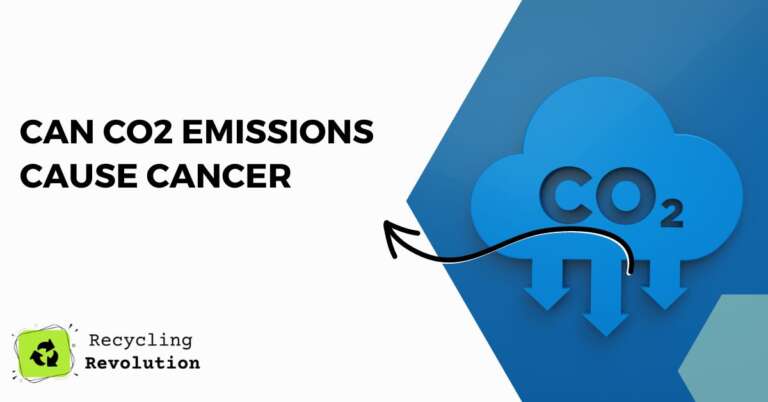Amidst all the noise surrounding climate change, there’s a less-discussed angle that deserves our attention: the potential link between CO2 emissions and cancer. While most of us understand the association between carbon emissions and global warming, few realize that this pervasive greenhouse gas might have more direct health implications than previously thought.
tl;dr: There isn’t direct evidence suggesting CO2 causes cancer. However, CO2 emissions contribute to air pollution and other environmental changes, which are associated with increased health risks.
CO2 and Its Primary Sources
Carbon dioxide (CO2) is a naturally occurring gas essential for the life cycle of plants and animals. It becomes problematic when human activities, like burning fossil fuels, release excessive amounts into the atmosphere.
According to the Environmental Protection Agency (EPA), the primary sources of CO2 emissions include:
- Electricity production (38.2%)
- Transportation (29%)
- Industry (22%)
These sectors, especially energy production, play vital roles in our daily lives. But their environmental footprint cannot be ignored.
Direct Impact of CO2 on Health
Unlike some harmful pollutants, CO2 doesn’t have a direct toxic effect on the human body in normal atmospheric concentrations. The issue arises from the indirect effects of increased CO2 levels.
For instance, elevated CO2 levels can lead to higher temperatures, resulting in the formation of ground-level ozone. According to the World Health Organization (WHO), ground-level ozone is a major component of urban smog and has been linked to respiratory problems and other health issues.
Note: Breathing in pure CO2 is dangerous and can be lethal, but this is not a concern with atmospheric concentrations.
CO2 Emissions, Air Pollution, and Cancer
While CO2 itself isn’t a carcinogen, its contribution to air pollution and the changes it instigates in our environment can indirectly increase cancer risks. Here’s how:
Particulate Matter and Lung Cancer
When fossil fuels burn, they release not only CO2 but also a mix of pollutants, including particulate matter (PM). Studies have consistently linked PM exposure to increased lung cancer risks.
Ground-Level Ozone and Respiratory Diseases
As mentioned earlier, CO2 can lead to the formation of ground-level ozone, which irritates the lungs and can worsen chronic respiratory diseases. Over time, chronic inflammation and repeated injury to lung tissues can increase cancer risks.
Climate Change and Aflatoxins
A lesser-known consequence of rising CO2 levels is their effect on mycotoxins such as aflatoxins. Produced by certain molds that grow on food, aflatoxins are potent carcinogens. According to studies, climate changes caused by increased CO2 can raise aflatoxin levels in crops, potentially elevating the risk of liver cancer among populations consuming contaminated food.
CO2 Emissions and Lifestyle-Related Cancers
Another angle to consider is how the changes brought about by CO2 emissions might indirectly promote lifestyles associated with higher cancer risks.
Urbanization and Sedentary Lifestyles
Cities often have higher CO2 emissions due to concentrated transportation and industrial activities. Urban living can sometimes lead to sedentary lifestyles, with residents less likely to engage in physical activity. According to the WHO, a lack of physical activity is a known risk factor for certain cancers, including breast and colon cancers.
Changes in Diet
Increased CO2 levels can affect the nutritional quality of some staple crops, potentially leading to deficiencies. While the direct link between CO2, nutrition, and cancer isn’t established, changes in dietary patterns can influence cancer risk.
Note: It’s essential to understand that many factors, including genetics and other environmental elements, play a role in cancer development. CO2-related factors are just one piece of the puzzle.
The Indirect Affects of CO2 Emissions on Health
The conversation around CO2 emissions and their implications often revolves around climate change. But, as we’ve explained earlier, the health impacts are equally significant. Beyond the more direct ties to cancer, CO2 emissions play a role in a myriad of indirect health consequences that deserve our attention.
Increased temperatures, one of the primary outcomes of rising CO2 levels, can lead to more extended seasons and expanded geographic ranges for disease vectors like mosquitoes. Some of these diseases, while not directly linked to cancer, can pose significant health risks.
Hepatitis B and Liver Cancer
The Hepatitis B virus, transmitted by blood and bodily fluids, has a higher incidence in many areas plagued by vector-borne diseases like malaria. Chronic Hepatitis B infection is a leading cause of liver cancer.
While the link between CO2, global warming, and liver cancer might seem tenuous, it’s an example of how complex and intertwined these systems can be. According to the World Health Organization, 27% of liver cancer cases are attributable to Hepatitis B, highlighting the scale of the issue.
Water Contamination and Gastrointestinal Cancers
Excessive CO2 emissions are a driving factor behind climate change, leading to more frequent and intense natural disasters. Events like hurricanes and floods can compromise local water supplies.
Arsenic Exposure
Contaminated water can contain elevated levels of harmful substances like arsenic. According to studies, chronic exposure to arsenic, often from drinking water, has been associated with a higher risk of bladder, lung, and skin cancers.
CO2, Ocean Acidification, and Dietary Implications
The world’s oceans absorb a significant portion of atmospheric CO2, leading to ocean acidification. This process can have profound effects on marine life, especially shellfish and corals.
Consumption of Contaminated Seafood
As the oceanic ecosystems are disrupted, toxins can bioaccumulate in fish and shellfish. Regularly consuming contaminated seafood can increase the risk of several health issues. For instance, some marine toxins are known to be carcinogenic. A notable example is ciguatoxin, which can lead to ciguatera fish poisoning. Though rare, there’s potential for such toxins to be linked with cancer, warranting further investigation.
Air Quality, Respiratory Health, and Systemic Inflammation
Beyond the previously discussed ground-level ozone and particulate matter, deteriorating air quality due to CO2 emissions can lead to systemic inflammation in the body.
Inflammation and Cancer
Chronic inflammation is a known risk factor for several cancers. Polluted air can lead to respiratory inflammation, but the inflammatory markers can also spread systemically. Over time, chronic systemic inflammation might increase the risk of cancers in various organs, not just the lungs.
Note: While the inflammatory pathway is well-recognized in the development of cancer, the exact role of air pollution-induced inflammation in cancerogenesis remains a topic of ongoing research.
Mitigating Exposure: The Role of Green Spaces
In urban areas with high CO2 emissions, green spaces play a crucial role in mitigating some of the health risks. Trees and plants absorb CO2, improving air quality, and reducing the urban heat island effect. There’s growing evidence that access to green spaces can also improve mental health and reduce the risk of chronic diseases.
While the direct correlation between green spaces and reduced cancer risk is still under investigation, it’s clear that such areas can offer protective health benefits against the backdrop of rising CO2 emissions.
In the intricate web of global health, CO2 emissions are but one factor. However, their cascading effects on our environment, and subsequently on our health, are undeniable. Whether it’s through the contamination of our food and water or the very air we breathe, CO2 emissions touch our lives in ways we are only beginning to understand fully.
CO2 Emissions: Interactions with Other Pollutants and Multiplier Effects
While CO2 often takes center stage in climate discussions, its interactions with other pollutants and the resulting multiplier effects further emphasize its far-reaching impact. To understand the full scope of how CO2 emissions might influence health, and indirectly cancer, we must broaden our lens.
CO2 doesn’t act alone in the atmosphere. It interacts with other greenhouse gases, like methane (CH4) and nitrous oxide (N2O), intensifying global warming.
Amplification of Harmful Emissions
Certain activities produce both CO2 and other pollutants. For instance, livestock farming emits methane, while fertilizers can release nitrous oxide. When these activities also involve burning fossil fuels, they release CO2, creating a double-whammy effect on the environment.
Sulphur Dioxide (SO2) and Coal Combustion
Coal combustion is one of the largest sources of CO2 emissions. However, coal also contains sulfur, which, when burned, forms sulfur dioxide (SO2). While SO2 can cool the atmosphere temporarily by reflecting sunlight, it poses a direct health threat.
Respiratory Diseases and Acid Rain
SO2 can irritate the respiratory system, and when combined with water vapor, it forms acid rain. Acid rain can harm freshwater ecosystems and vegetation. Disturbed ecosystems can indirectly affect human health and might play a role in the complex web of factors that increase cancer risk, particularly due to the consumption of contaminated water and food.
Urban Heat Islands and Localized Air Pollutants
CO2 emissions contribute to global warming, which can exacerbate urban heat islands – localized areas where temperatures are significantly warmer than their surroundings.
Enhanced Pollutant Concentrations
Higher temperatures can intensify the concentration of pollutants. In urban settings, this can lead to a cocktail of toxins in the air, including polycyclic aromatic hydrocarbons (PAHs), which are known carcinogens.
Black Carbon and its Dual Role
Black carbon, commonly referred to as soot, is a byproduct of incomplete combustion of fossil fuels. It’s a significant contributor to global warming, second only to CO2.
Direct Inhalation and Health Risks
Black carbon particles can penetrate deep into the lungs, causing respiratory issues. Moreover, according to some studies, long-term exposure to fine particulate pollutants, including black carbon, is associated with an increased risk of cancers, notably lung cancer.
CO2 Emissions, Forest Degradation, and Biodiversity Loss
Forests play a crucial role in sequestering CO2, but deforestation results in vast amounts of CO2 release. Beyond the immediate release, the loss of forests means losing a crucial buffer against future emissions.
Biodiversity Loss and Potential Zoonotic Diseases
Forests are rich reservoirs of biodiversity. Deforestation can lead to increased interactions between wildlife and humans, increasing the risk of zoonotic diseases. While not directly related to cancer, this highlights another facet of how CO2 emissions impact human health.
By recognizing the multitude of ways CO2 emissions interplay with other pollutants and environmental factors, we gain a clearer picture of their pervasive impact. These interactions amplify existing risks and introduce new challenges, emphasizing the urgency of addressing CO2 emissions from a multi-disciplinary perspective. The ties to cancer, while complex, are an essential component of this intricate puzzle.
Conclusion
The potential link between CO2 emissions and cancer is a multifaceted issue that extends beyond the direct effects of carbon dioxide on global warming. While CO2 itself isn’t a carcinogen, its indirect contributions to air pollution and environmental changes can elevate cancer risks.
For instance, burning fossil fuels releases not only CO2 but also harmful pollutants like particulate matter, which is linked to lung cancer. Elevated CO2 levels can also lead to ground-level ozone formation, associated with respiratory problems.
Furthermore, climate changes influenced by CO2 can increase aflatoxin levels in crops, heightening liver cancer risks. Urbanization, driven by high CO2 emissions, promotes sedentary lifestyles and dietary changes, both of which have implications for cancer.
Additionally, CO2’s interactions with other pollutants, such as black carbon and sulfur dioxide, compound its health impacts. In essence, while CO2’s direct link to cancer remains complex, its cascading environmental and health effects are undeniable and warrant comprehensive attention.

